Management Accounting Report: Costs, Decisions, and Financial Analysis
VerifiedAdded on 2020/09/17
|6
|1330
|31
Report
AI Summary
This report provides an overview of management accounting costs and their significance in organizational decision-making. It begins with an introduction to management accounting, highlighting its role in preparing financial reports and supporting business decisions. The report then delves into various types of costs, including direct, indirect, variable, fixed, and operating costs, providing definitions and examples for each. It also discusses the nature and behavior of these costs, emphasizing the importance of separating fixed and variable costs for cost control, decision-making, marginal costing, and CVP analysis. Furthermore, the report explores the relevance of these costs in the decision-making process, explaining how each cost type influences financial decisions. It underscores the importance of cost accounting in evaluating costs associated with products, production, and projects, ultimately aiding managers in making informed financial decisions. The report concludes by summarizing the significant role of management accounting costs in financial matters and their impact on business effectiveness.
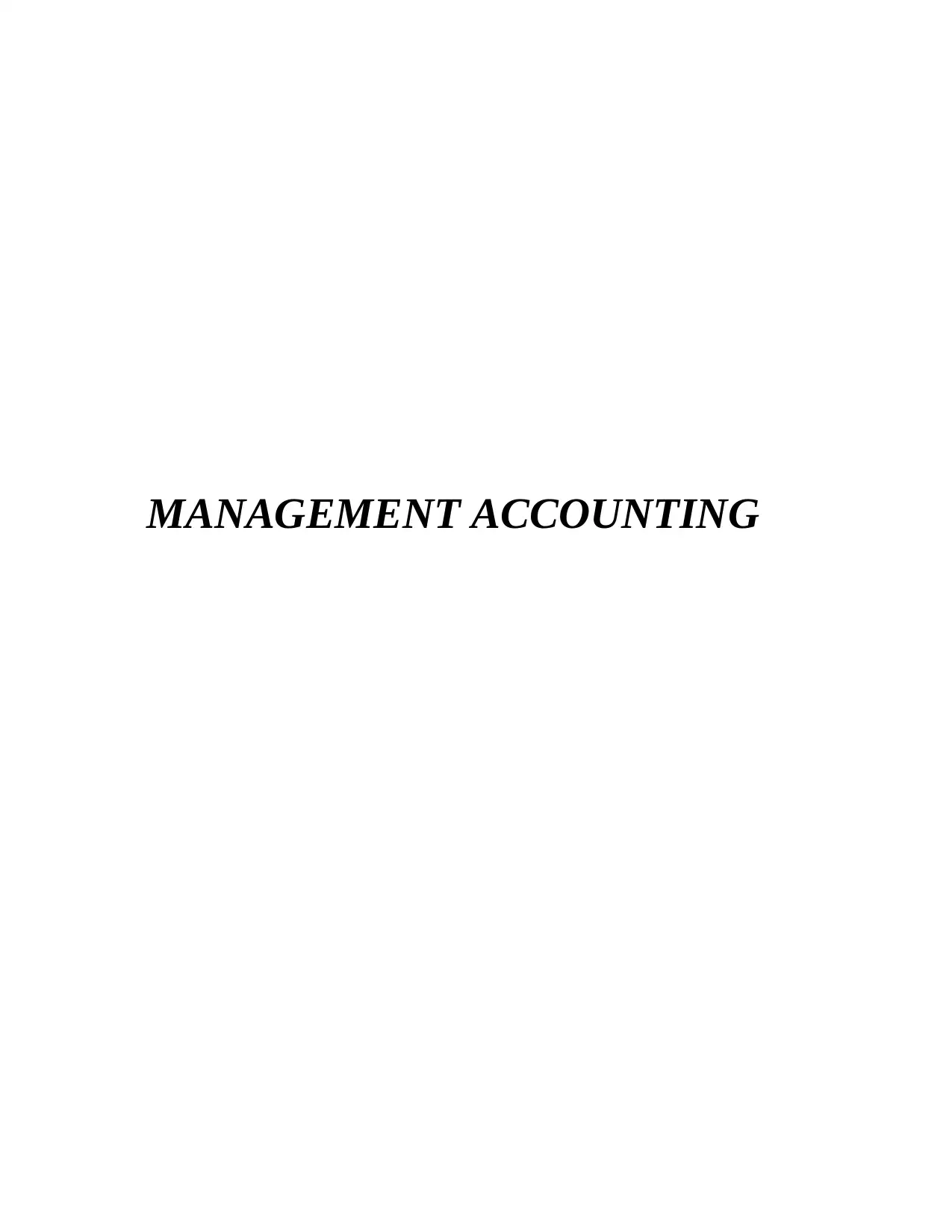
MANAGEMENT ACCOUNTING
Paraphrase This Document
Need a fresh take? Get an instant paraphrase of this document with our AI Paraphraser
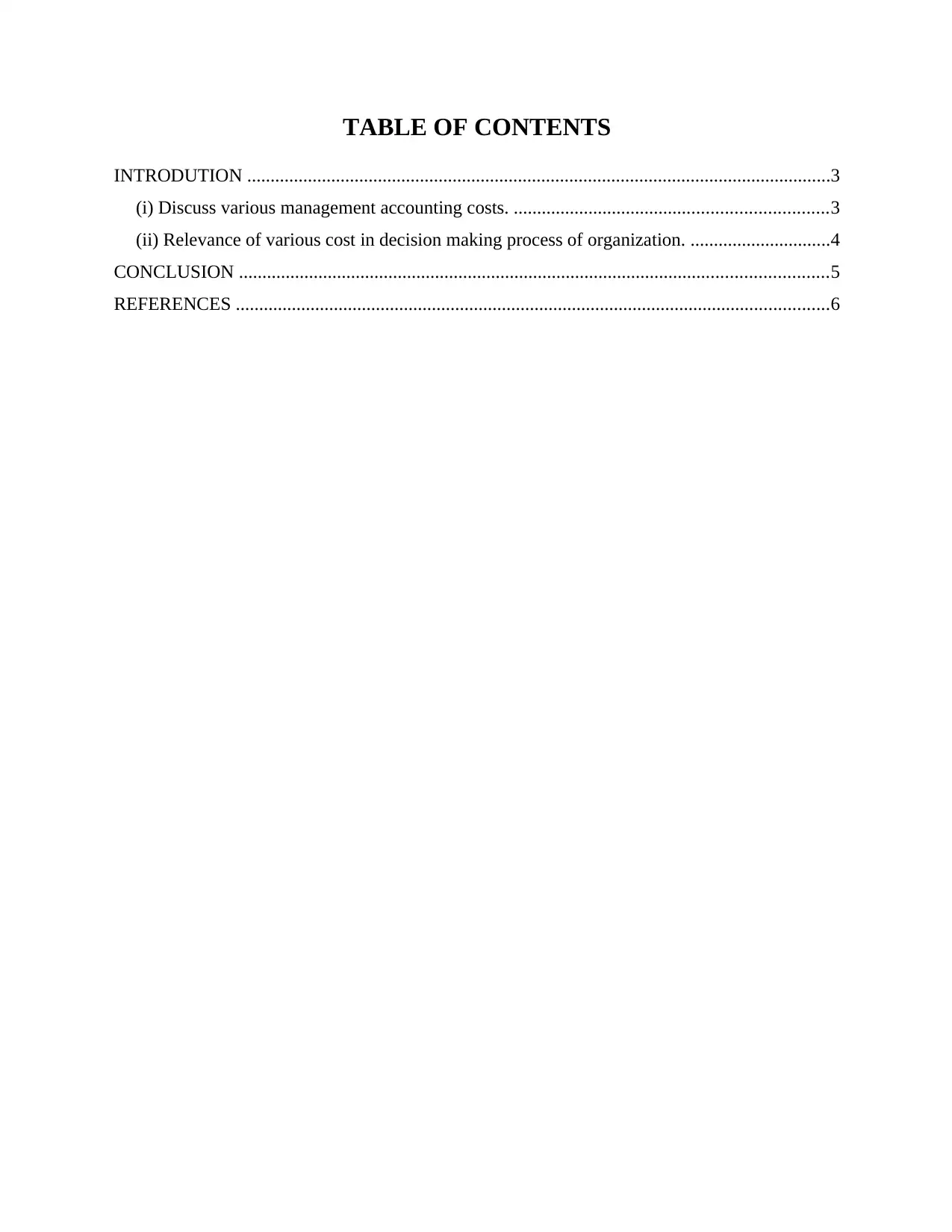
TABLE OF CONTENTS
INTRODUTION .............................................................................................................................3
(i) Discuss various management accounting costs. ...................................................................3
(ii) Relevance of various cost in decision making process of organization. ..............................4
CONCLUSION ..............................................................................................................................5
REFERENCES ...............................................................................................................................6
INTRODUTION .............................................................................................................................3
(i) Discuss various management accounting costs. ...................................................................3
(ii) Relevance of various cost in decision making process of organization. ..............................4
CONCLUSION ..............................................................................................................................5
REFERENCES ...............................................................................................................................6
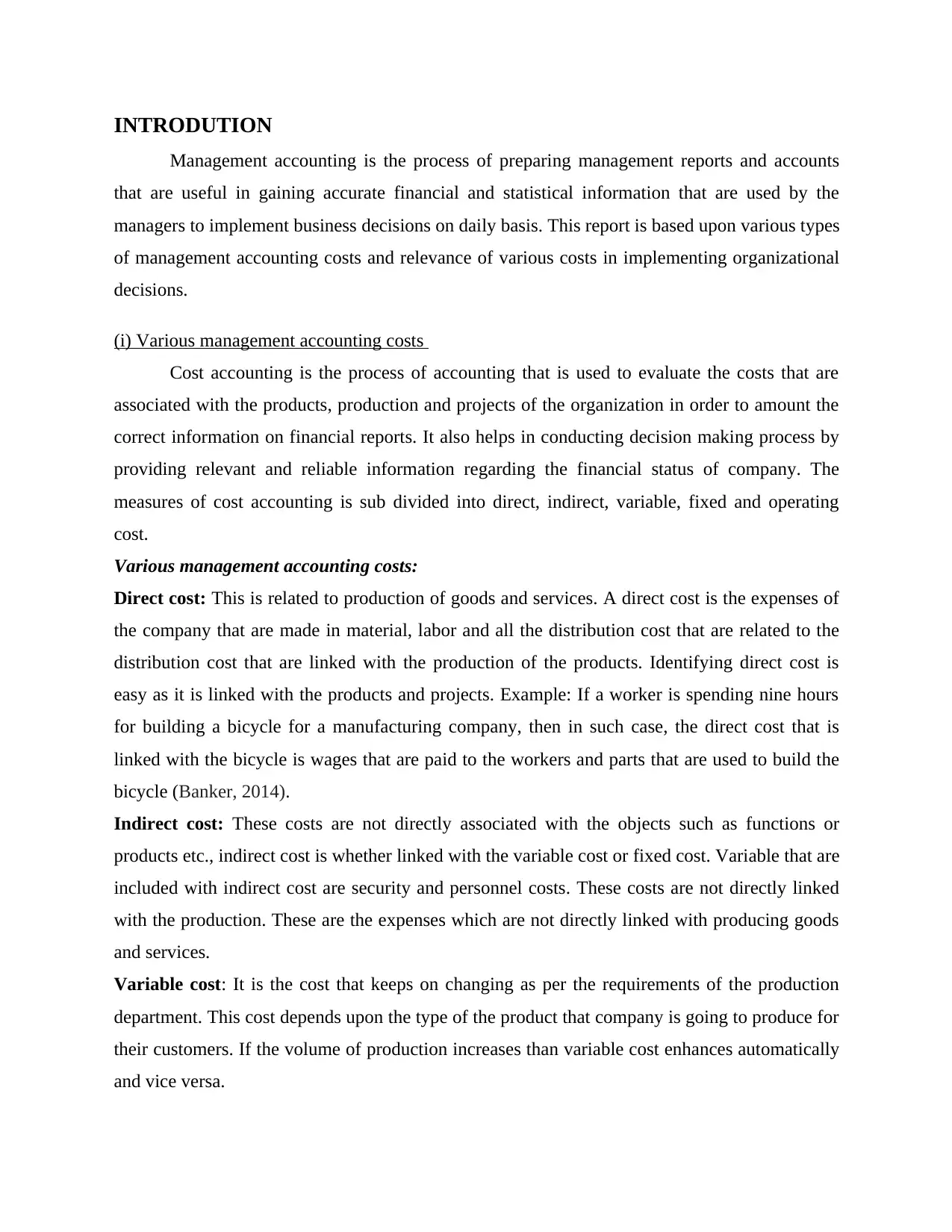
INTRODUTION
Management accounting is the process of preparing management reports and accounts
that are useful in gaining accurate financial and statistical information that are used by the
managers to implement business decisions on daily basis. This report is based upon various types
of management accounting costs and relevance of various costs in implementing organizational
decisions.
(i) Various management accounting costs
Cost accounting is the process of accounting that is used to evaluate the costs that are
associated with the products, production and projects of the organization in order to amount the
correct information on financial reports. It also helps in conducting decision making process by
providing relevant and reliable information regarding the financial status of company. The
measures of cost accounting is sub divided into direct, indirect, variable, fixed and operating
cost.
Various management accounting costs:
Direct cost: This is related to production of goods and services. A direct cost is the expenses of
the company that are made in material, labor and all the distribution cost that are related to the
distribution cost that are linked with the production of the products. Identifying direct cost is
easy as it is linked with the products and projects. Example: If a worker is spending nine hours
for building a bicycle for a manufacturing company, then in such case, the direct cost that is
linked with the bicycle is wages that are paid to the workers and parts that are used to build the
bicycle (Banker, 2014).
Indirect cost: These costs are not directly associated with the objects such as functions or
products etc., indirect cost is whether linked with the variable cost or fixed cost. Variable that are
included with indirect cost are security and personnel costs. These costs are not directly linked
with the production. These are the expenses which are not directly linked with producing goods
and services.
Variable cost: It is the cost that keeps on changing as per the requirements of the production
department. This cost depends upon the type of the product that company is going to produce for
their customers. If the volume of production increases than variable cost enhances automatically
and vice versa.
Management accounting is the process of preparing management reports and accounts
that are useful in gaining accurate financial and statistical information that are used by the
managers to implement business decisions on daily basis. This report is based upon various types
of management accounting costs and relevance of various costs in implementing organizational
decisions.
(i) Various management accounting costs
Cost accounting is the process of accounting that is used to evaluate the costs that are
associated with the products, production and projects of the organization in order to amount the
correct information on financial reports. It also helps in conducting decision making process by
providing relevant and reliable information regarding the financial status of company. The
measures of cost accounting is sub divided into direct, indirect, variable, fixed and operating
cost.
Various management accounting costs:
Direct cost: This is related to production of goods and services. A direct cost is the expenses of
the company that are made in material, labor and all the distribution cost that are related to the
distribution cost that are linked with the production of the products. Identifying direct cost is
easy as it is linked with the products and projects. Example: If a worker is spending nine hours
for building a bicycle for a manufacturing company, then in such case, the direct cost that is
linked with the bicycle is wages that are paid to the workers and parts that are used to build the
bicycle (Banker, 2014).
Indirect cost: These costs are not directly associated with the objects such as functions or
products etc., indirect cost is whether linked with the variable cost or fixed cost. Variable that are
included with indirect cost are security and personnel costs. These costs are not directly linked
with the production. These are the expenses which are not directly linked with producing goods
and services.
Variable cost: It is the cost that keeps on changing as per the requirements of the production
department. This cost depends upon the type of the product that company is going to produce for
their customers. If the volume of production increases than variable cost enhances automatically
and vice versa.
⊘ This is a preview!⊘
Do you want full access?
Subscribe today to unlock all pages.

Trusted by 1+ million students worldwide
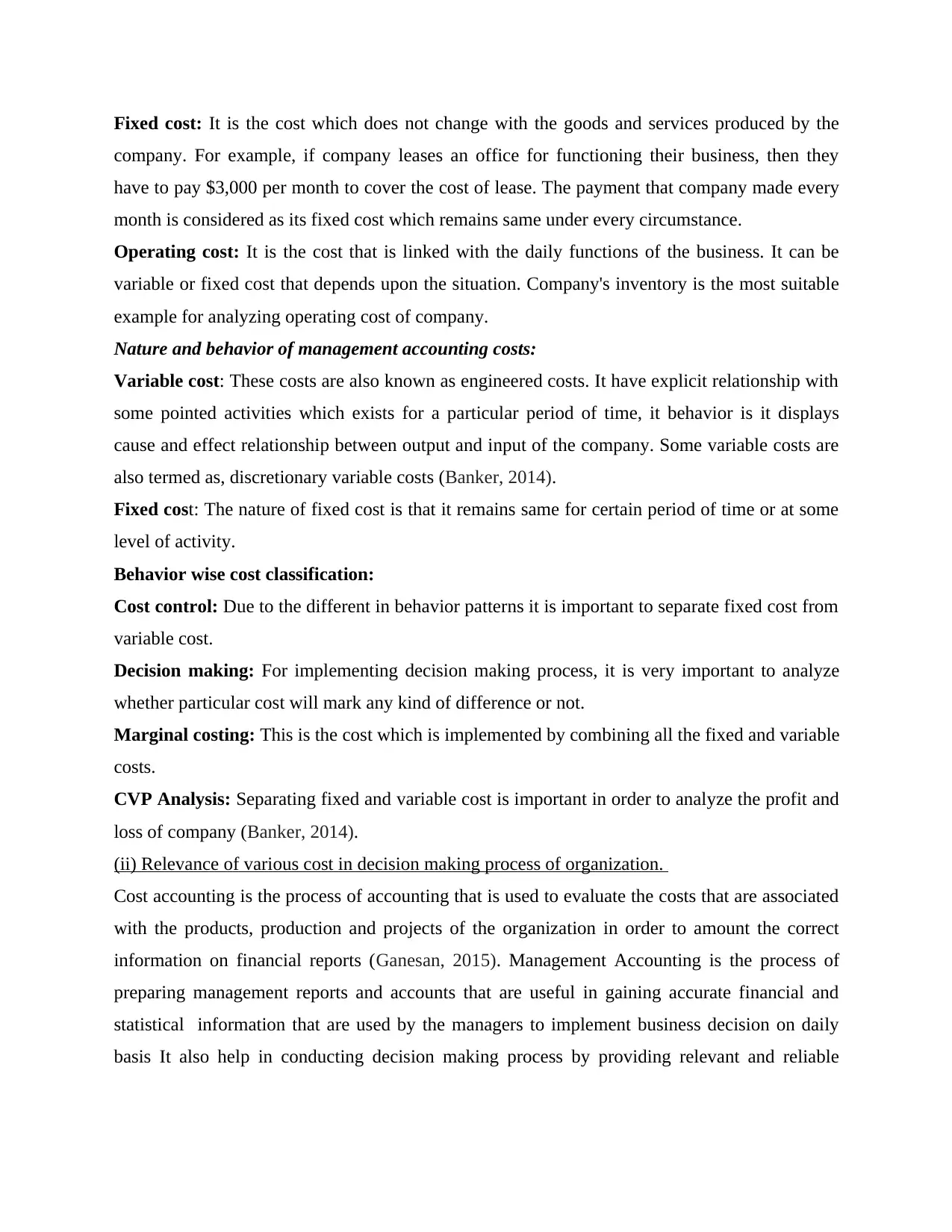
Fixed cost: It is the cost which does not change with the goods and services produced by the
company. For example, if company leases an office for functioning their business, then they
have to pay $3,000 per month to cover the cost of lease. The payment that company made every
month is considered as its fixed cost which remains same under every circumstance.
Operating cost: It is the cost that is linked with the daily functions of the business. It can be
variable or fixed cost that depends upon the situation. Company's inventory is the most suitable
example for analyzing operating cost of company.
Nature and behavior of management accounting costs:
Variable cost: These costs are also known as engineered costs. It have explicit relationship with
some pointed activities which exists for a particular period of time, it behavior is it displays
cause and effect relationship between output and input of the company. Some variable costs are
also termed as, discretionary variable costs (Banker, 2014).
Fixed cost: The nature of fixed cost is that it remains same for certain period of time or at some
level of activity.
Behavior wise cost classification:
Cost control: Due to the different in behavior patterns it is important to separate fixed cost from
variable cost.
Decision making: For implementing decision making process, it is very important to analyze
whether particular cost will mark any kind of difference or not.
Marginal costing: This is the cost which is implemented by combining all the fixed and variable
costs.
CVP Analysis: Separating fixed and variable cost is important in order to analyze the profit and
loss of company (Banker, 2014).
(ii) Relevance of various cost in decision making process of organization.
Cost accounting is the process of accounting that is used to evaluate the costs that are associated
with the products, production and projects of the organization in order to amount the correct
information on financial reports (Ganesan, 2015). Management Accounting is the process of
preparing management reports and accounts that are useful in gaining accurate financial and
statistical information that are used by the managers to implement business decision on daily
basis It also help in conducting decision making process by providing relevant and reliable
company. For example, if company leases an office for functioning their business, then they
have to pay $3,000 per month to cover the cost of lease. The payment that company made every
month is considered as its fixed cost which remains same under every circumstance.
Operating cost: It is the cost that is linked with the daily functions of the business. It can be
variable or fixed cost that depends upon the situation. Company's inventory is the most suitable
example for analyzing operating cost of company.
Nature and behavior of management accounting costs:
Variable cost: These costs are also known as engineered costs. It have explicit relationship with
some pointed activities which exists for a particular period of time, it behavior is it displays
cause and effect relationship between output and input of the company. Some variable costs are
also termed as, discretionary variable costs (Banker, 2014).
Fixed cost: The nature of fixed cost is that it remains same for certain period of time or at some
level of activity.
Behavior wise cost classification:
Cost control: Due to the different in behavior patterns it is important to separate fixed cost from
variable cost.
Decision making: For implementing decision making process, it is very important to analyze
whether particular cost will mark any kind of difference or not.
Marginal costing: This is the cost which is implemented by combining all the fixed and variable
costs.
CVP Analysis: Separating fixed and variable cost is important in order to analyze the profit and
loss of company (Banker, 2014).
(ii) Relevance of various cost in decision making process of organization.
Cost accounting is the process of accounting that is used to evaluate the costs that are associated
with the products, production and projects of the organization in order to amount the correct
information on financial reports (Ganesan, 2015). Management Accounting is the process of
preparing management reports and accounts that are useful in gaining accurate financial and
statistical information that are used by the managers to implement business decision on daily
basis It also help in conducting decision making process by providing relevant and reliable
Paraphrase This Document
Need a fresh take? Get an instant paraphrase of this document with our AI Paraphraser
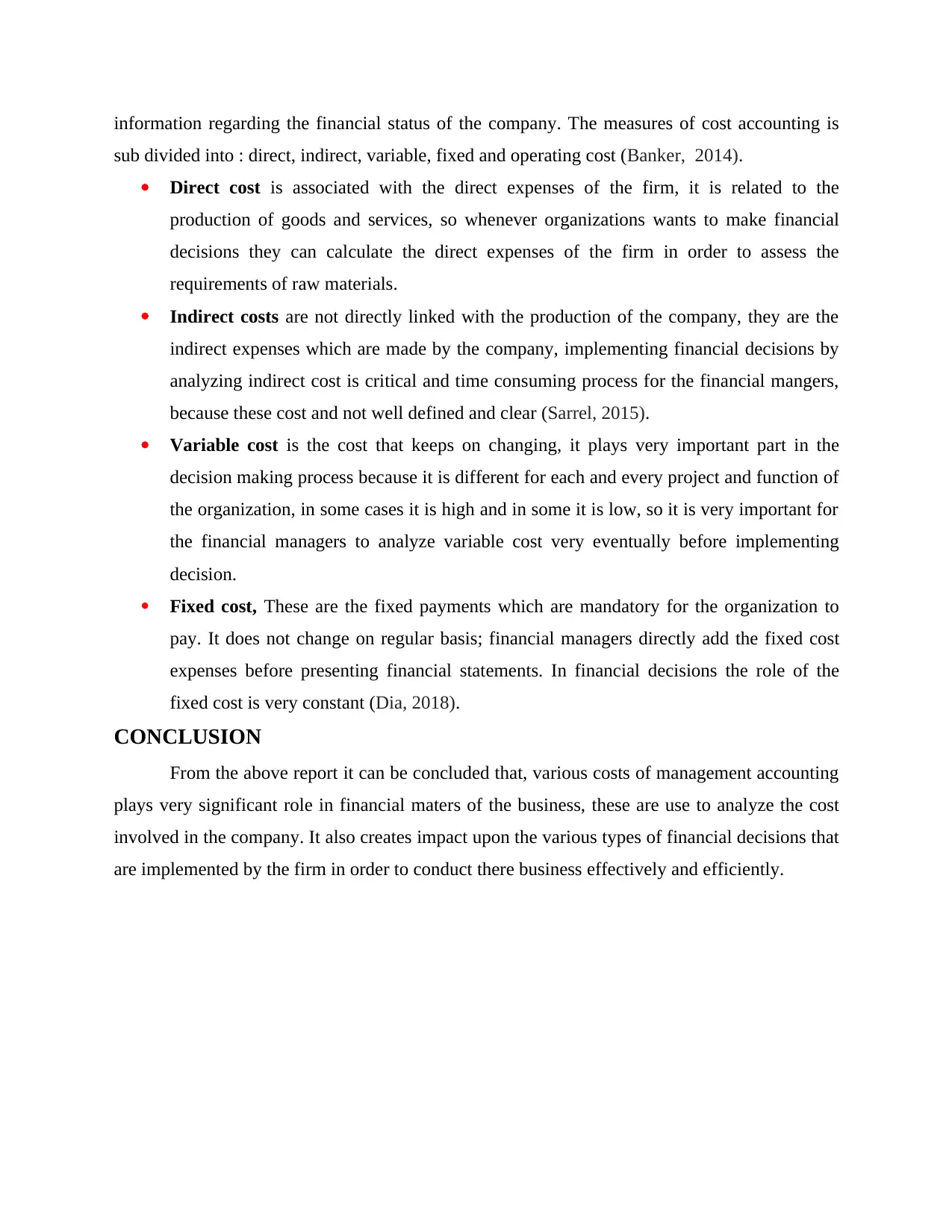
information regarding the financial status of the company. The measures of cost accounting is
sub divided into : direct, indirect, variable, fixed and operating cost (Banker, 2014).
Direct cost is associated with the direct expenses of the firm, it is related to the
production of goods and services, so whenever organizations wants to make financial
decisions they can calculate the direct expenses of the firm in order to assess the
requirements of raw materials.
Indirect costs are not directly linked with the production of the company, they are the
indirect expenses which are made by the company, implementing financial decisions by
analyzing indirect cost is critical and time consuming process for the financial mangers,
because these cost and not well defined and clear (Sarrel, 2015).
Variable cost is the cost that keeps on changing, it plays very important part in the
decision making process because it is different for each and every project and function of
the organization, in some cases it is high and in some it is low, so it is very important for
the financial managers to analyze variable cost very eventually before implementing
decision.
Fixed cost, These are the fixed payments which are mandatory for the organization to
pay. It does not change on regular basis; financial managers directly add the fixed cost
expenses before presenting financial statements. In financial decisions the role of the
fixed cost is very constant (Dia, 2018).
CONCLUSION
From the above report it can be concluded that, various costs of management accounting
plays very significant role in financial maters of the business, these are use to analyze the cost
involved in the company. It also creates impact upon the various types of financial decisions that
are implemented by the firm in order to conduct there business effectively and efficiently.
sub divided into : direct, indirect, variable, fixed and operating cost (Banker, 2014).
Direct cost is associated with the direct expenses of the firm, it is related to the
production of goods and services, so whenever organizations wants to make financial
decisions they can calculate the direct expenses of the firm in order to assess the
requirements of raw materials.
Indirect costs are not directly linked with the production of the company, they are the
indirect expenses which are made by the company, implementing financial decisions by
analyzing indirect cost is critical and time consuming process for the financial mangers,
because these cost and not well defined and clear (Sarrel, 2015).
Variable cost is the cost that keeps on changing, it plays very important part in the
decision making process because it is different for each and every project and function of
the organization, in some cases it is high and in some it is low, so it is very important for
the financial managers to analyze variable cost very eventually before implementing
decision.
Fixed cost, These are the fixed payments which are mandatory for the organization to
pay. It does not change on regular basis; financial managers directly add the fixed cost
expenses before presenting financial statements. In financial decisions the role of the
fixed cost is very constant (Dia, 2018).
CONCLUSION
From the above report it can be concluded that, various costs of management accounting
plays very significant role in financial maters of the business, these are use to analyze the cost
involved in the company. It also creates impact upon the various types of financial decisions that
are implemented by the firm in order to conduct there business effectively and efficiently.
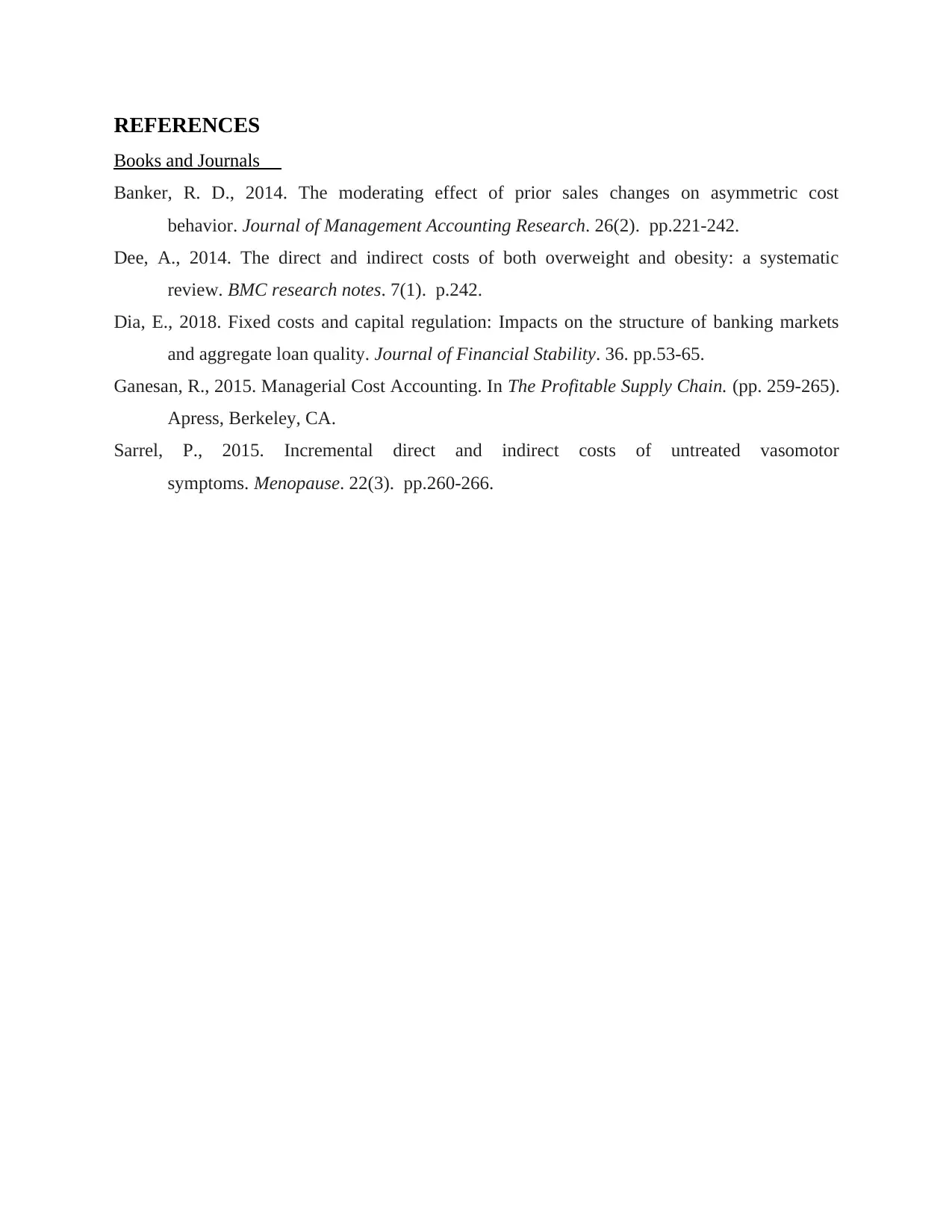
REFERENCES
Books and Journals
Banker, R. D., 2014. The moderating effect of prior sales changes on asymmetric cost
behavior. Journal of Management Accounting Research. 26(2). pp.221-242.
Dee, A., 2014. The direct and indirect costs of both overweight and obesity: a systematic
review. BMC research notes. 7(1). p.242.
Dia, E., 2018. Fixed costs and capital regulation: Impacts on the structure of banking markets
and aggregate loan quality. Journal of Financial Stability. 36. pp.53-65.
Ganesan, R., 2015. Managerial Cost Accounting. In The Profitable Supply Chain. (pp. 259-265).
Apress, Berkeley, CA.
Sarrel, P., 2015. Incremental direct and indirect costs of untreated vasomotor
symptoms. Menopause. 22(3). pp.260-266.
Books and Journals
Banker, R. D., 2014. The moderating effect of prior sales changes on asymmetric cost
behavior. Journal of Management Accounting Research. 26(2). pp.221-242.
Dee, A., 2014. The direct and indirect costs of both overweight and obesity: a systematic
review. BMC research notes. 7(1). p.242.
Dia, E., 2018. Fixed costs and capital regulation: Impacts on the structure of banking markets
and aggregate loan quality. Journal of Financial Stability. 36. pp.53-65.
Ganesan, R., 2015. Managerial Cost Accounting. In The Profitable Supply Chain. (pp. 259-265).
Apress, Berkeley, CA.
Sarrel, P., 2015. Incremental direct and indirect costs of untreated vasomotor
symptoms. Menopause. 22(3). pp.260-266.
⊘ This is a preview!⊘
Do you want full access?
Subscribe today to unlock all pages.

Trusted by 1+ million students worldwide
1 out of 6
Related Documents
Your All-in-One AI-Powered Toolkit for Academic Success.
+13062052269
info@desklib.com
Available 24*7 on WhatsApp / Email
![[object Object]](/_next/static/media/star-bottom.7253800d.svg)
Unlock your academic potential
Copyright © 2020–2025 A2Z Services. All Rights Reserved. Developed and managed by ZUCOL.





